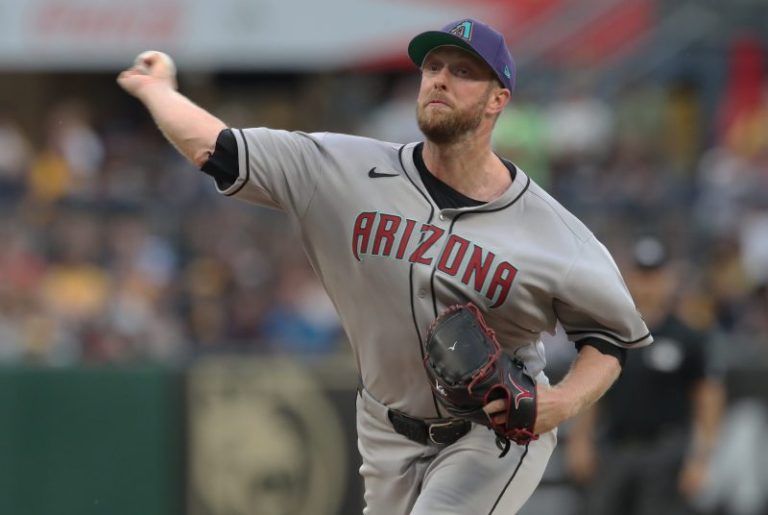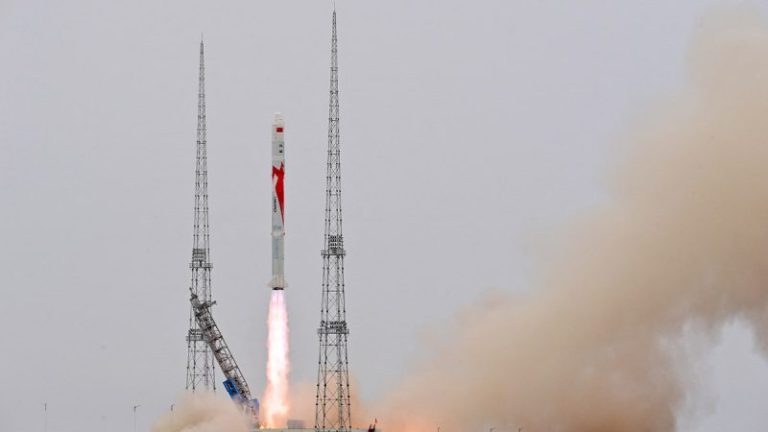Two tickets to the NCAA volleyball Final Four have been punched, with No. 1 seeds Pitt and Kentucky advancing on Saturday.
The Panthers and Wildcats await their opponents. The regional semifinals conclude on Sunday, Dec. 14. Pitt will play the winner of Nebraska vs. Texas A&M (3 p.m. ET, ABC). Kentucky will play the winner of Wisconsin vs. Texas (7:30 p.m. ET, ESPN).
Nebraska is the tournament’s No. 1 overall seed and looking for its first championship since 2017 and first under coach Dani Busboom Kelly. Setter Bergen Reilly, middle blocker Rebekah Allick and middle blocker Andi Jackson have led the Huskers to a 33-0 record.
Texas, the final No. 1 seed, is 13-1 on its home floor and will host the regional final at Gregory Gymnasium in Austin.
The Final Four will be held at the T-Mobile Center in Kansas City, Missouri. The two semifinal matches will take place on Thursday, Dec. 18 and will be broadcast on ESPN. The national championship game is Sunday, Dec. 21 on ABC.
Texas A&M arrivals
When is NCAA women’s volleyball regional final?
Date: Dec. 14
Time: Two matches Sunday. Match-by-match times below.
How to watch NCAA volleyball tournament
Streaming: ESPN+ ∣ Fubo (free trial)
The 2025 NCAA women’s volleyball tournament will air across the ESPN and ABC family of networks. Games can be streamed on ESPN+, ESPN’s subscription streaming service, and Fubo, which offers a free trial to potential subscribers.
NCAA volleyball regional final: Times, TV
All times Eastern
Saturday, Dec. 13
No. 1 Kentucky 3, No. 3 Creighton 0
No. 1 Pittsburgh 3, No. 3 Purdue 1
Sunday, Dec. 14
No. 3 Texas A&M vs. No. 1 Nebraska, 3 p.m. | ABC
No. 3 Wisconsin vs. No. 1 Texas, 7:30 p.m. | ESPN
When is the NCAA volleyball Final Four in 2025?
Dates: Thursday, Dec. 18 and Sunday, Dec. 21
The two semifinal matches in the Final Four of the 2025 NCAA volleyball tournament will take place on Thursday, Dec. 18 and will be broadcast on ESPN. The national championship game is Sunday, Dec. 21 on ABC.
Round of 16 volleyball results
Thursday, Dec. 11
No. 3 Creighton 3, No. 2 Arizona State 1
No. 1 Kentucky 3, Cal Poly 0
No. 1 Pittsburgh 3, No. 4 Minnesota 0
No. 3 Purdue 3, No. 2 SMU 1
Friday, Dec. 12
No. 1 Texas 3, No. 4 Indiana 0
No. 3 Wisconsin 3, No. 2 Stanford 1
No. 3 Texas A&M 3, No. 2 Louisville 2
No. 1 Nebraska 3, No. 4 Kansas 0
NCAA volleyball second-round results
Lexington bracket
No. 1 Kentucky 3, No. 8 UCLA 1 (30-28, 25-16, 28-30, 25-17)
No. 3 Creighton 3, No. 6 Northern Iowa 1 (25-18, 23-25, 25-22, 25-21)
No. 2 Arizona State 3, Utah State 1 (25-15, 25-18, 22-25, 25-15)
Cal Poly 3, No. 4 USC 2 (25-19, 25-20, 20-25, 14-25, 15-7)
Austin bracket
No. 4 Indiana 3, No. 5 Colorado 0 (25-20, 25-17, 25-23)
No. 3 Wisconsin 3, North Carolina 0 (25-14, 25-21, 27-25)
No. 1 Texas 1, No. 8 Penn State 0 (25-16, 25-9, 25-19)
No. 2 Stanford 3, Arizona 1 (25-16, 25-27, 25-17, 25-20)
Pittsburgh bracket
No. 3 Purdue 3, No. 6 Baylor 1 (25-16, 25-19, 23-25, 25-20)
No. 1 Pittsburgh 3, Michigan 0 (25-23, 25-23, 25-18)
No. 2 SMU 3, Florida 0 (25-11, 25-21, 26-24)
No. 4 Minnesota 3, No. 5 Iowa State 0 (25-22, 25-21, 25-14)
Lincoln bracket
No. 4 Kansas 3, No. 5 Miami 1 (25-17, 25-22, 22-25, 27-25)
No. 2 Louisville 3, Marquette 2 (21-25, 25-11, 23-25, 25-19, 15-12)
No. 1 Nebraska 3, Kansas State 0 (25-17, 25-21, 25-16)
No. 3 Texas A&M 3, No. 6 TCU 1 (23-25, 25-23, 25-22, 29-27)
NCAA volleyball first-round results
Lexington bracket
No. 1 Kentucky 3, Wofford 0 (25-11, 25-19, 25-12)
No. 8 UCLA 3, Georgia Tech 2 (24-26, 25-19, 25-23, 25-18, 15-10)
Cal Poly 3, No. 5 BYU 2 (25-19, 17-25, 20-25, 25-20, 15-10)
No. 4 USC 3, Princeton 0, (25-19, 25-12, 25-13)
No. 3 Creighton 3, Northern Colorado 2 (12-25, 25-23,25-23,17-25, 8-15)
No. 6 Northern Iowa 3, Utah 2 (15-25, 21-25, 26-24, 25-20, 15-10)
Utah State 3, No. 7 Tennessee 2 (25-19, 25-15, 19-25, 25-18, 15-11)
No. 2 Arizona State 3, Coppin State 0 (25-11, 25-14, 25-12)
Austin bracket
No. 1 Texas 3, Florida A&M 0 (25-11, 25- 8, 25-14)
No. 8 Penn State 3, South Florida 1 (25-23, 12-25, 25-21, 25-19)
No. 5 Colorado 3, American 0 (25-16, 25-19, 25-16)
No. 4 Indiana 3, Toledo 0 (25-18, 25-15, 25-17)
No. 3 Wisconsin 3, Eastern Illinois 0 (25-11, 25-6, 25-19)
North Carolina 3, No. 6 UTEP 1 (24-26, 25-11, 25-18, 25-21)
Arizona 3, No. 7 South Dakota State 1 (25-21, 22-25, 25-15, 25-15)
No. 2 Stanford 3, Utah Valley 1 (21-25, 25-21, 25-13, 25-14)
Pittsburgh bracket
No. 1 Pitt 3, UMBC 0 (25-10, 25-17, 25-13)
Michigan 3, No. 8 Xavier 0 (25-19, 25-15, 25-23)
No. 5 Iowa State 3, St. Thomas-Minnesota 2 (21-25, 25-13, 25-16, 21-25, 15-8)
No. 4 Minnesota 3, Fairfield 0 (25-12, 25-7, 25-13)
No. 3 Purdue 3, Wright State 0 (25-13, 25-21, 25-19)
No. 6 Baylor 3, Arkansas State 2 (23-25, 25-20, 30-28, 23-25, 15-10)
Florida 3, No. 7 Rice 0 (27-25, 25-23, 25-19)
No. 2 SMU 3, Central Arkansas 0 (25-13, 25-13, 25-13)
Lincoln bracket
No. 1 Nebraska 3, Long Island 0 (25-11, 25-15, 25-17)
Kansas State 3, San Diego 2 (21-25, 25-17, 26-28, 25-22, 15-12)
No. 5 Miami 3, Tulsa 1 (25-22, 13-25, 25-22, 25-20)
No. 4 Kansas 3, High Point 0 (25-20, 25-15, 25-18)
No. 3 Texas A&M 3, Campbell 0 (25-20, 25-10, 25-13)
No. 6 TCU 3, Stephen F. Austin 0 (25-8, 26-24, 25-20)
Marquette 3, Western Kentucky 0 (25-22, 25-21, 25-16)
No. 2 Louisville 3, Loyola (Illinois) 0 (25-17, 25-9, 25-12)
NCAA volleyball tournament champions
Penn State is the reigning NCAA volleyball champion, having defeated Louisville in four sets last year in the national title game. It was the Nittany Lions’ eighth volleyball championship since 1999.
Here’s a look at the past 10 NCAA volleyball champions:
2024: Penn State
2023: Texas
2022: Texas
2021: Wisconsin
2020: Kentucky
2019: Stanford
2018: Stanford
2017: Nebraska
2016: Stanford
2015: Nebraska
The USA TODAY app gets you to the heart of the news — fast. Download for award-winning coverage, crosswords, audio storytelling, the eNewspaper and more.
This post appeared first on USA TODAY










